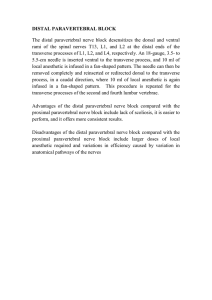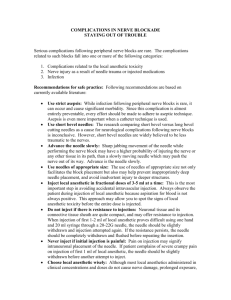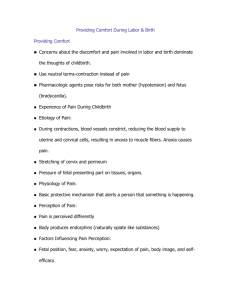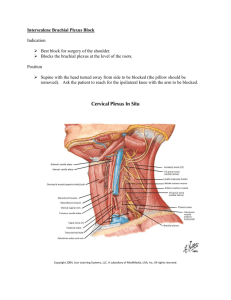proximal paravertbral nerve block
advertisement
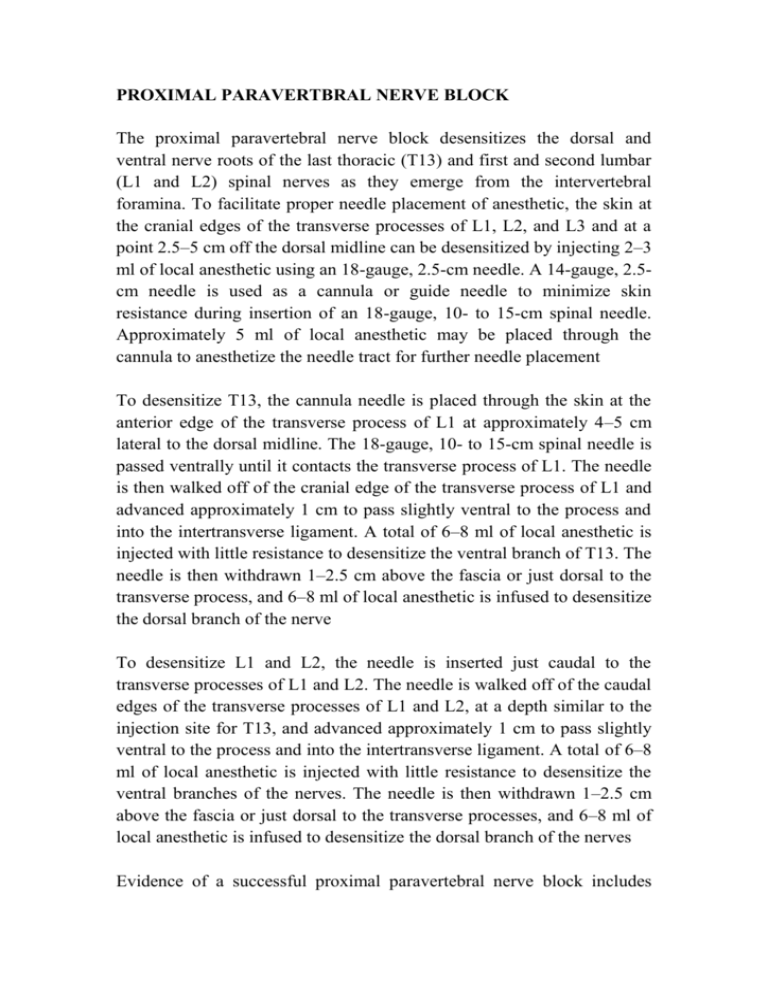
PROXIMAL PARAVERTBRAL NERVE BLOCK The proximal paravertebral nerve block desensitizes the dorsal and ventral nerve roots of the last thoracic (T13) and first and second lumbar (L1 and L2) spinal nerves as they emerge from the intervertebral foramina. To facilitate proper needle placement of anesthetic, the skin at the cranial edges of the transverse processes of L1, L2, and L3 and at a point 2.5–5 cm off the dorsal midline can be desensitized by injecting 2–3 ml of local anesthetic using an 18-gauge, 2.5-cm needle. A 14-gauge, 2.5cm needle is used as a cannula or guide needle to minimize skin resistance during insertion of an 18-gauge, 10- to 15-cm spinal needle. Approximately 5 ml of local anesthetic may be placed through the cannula to anesthetize the needle tract for further needle placement To desensitize T13, the cannula needle is placed through the skin at the anterior edge of the transverse process of L1 at approximately 4–5 cm lateral to the dorsal midline. The 18-gauge, 10- to 15-cm spinal needle is passed ventrally until it contacts the transverse process of L1. The needle is then walked off of the cranial edge of the transverse process of L1 and advanced approximately 1 cm to pass slightly ventral to the process and into the intertransverse ligament. A total of 6–8 ml of local anesthetic is injected with little resistance to desensitize the ventral branch of T13. The needle is then withdrawn 1–2.5 cm above the fascia or just dorsal to the transverse process, and 6–8 ml of local anesthetic is infused to desensitize the dorsal branch of the nerve To desensitize L1 and L2, the needle is inserted just caudal to the transverse processes of L1 and L2. The needle is walked off of the caudal edges of the transverse processes of L1 and L2, at a depth similar to the injection site for T13, and advanced approximately 1 cm to pass slightly ventral to the process and into the intertransverse ligament. A total of 6–8 ml of local anesthetic is injected with little resistance to desensitize the ventral branches of the nerves. The needle is then withdrawn 1–2.5 cm above the fascia or just dorsal to the transverse processes, and 6–8 ml of local anesthetic is infused to desensitize the dorsal branch of the nerves Evidence of a successful proximal paravertebral nerve block includes increased temperature of the skin; analgesia of the skin, muscles, and peritoneum of the abdominal wall of the paralumbar fossa; and scoliosis of the spine toward the desensitized side. Advantages of the proximal paravertebral nerve block include small doses of anesthetic, wide and uniform area of analgesia and muscle relaxation, decreased intra-abdominal pressure, and absence of the local anesthetic at the margins of the surgical site. Disadvantages of the proximal paravertebral nerve block include scoliosis of the spine, which may make closure of the incision more difficult; difficulty in identifying landmarks in obese and heavily muscled animals; and more skill or practice required for consistent results.
